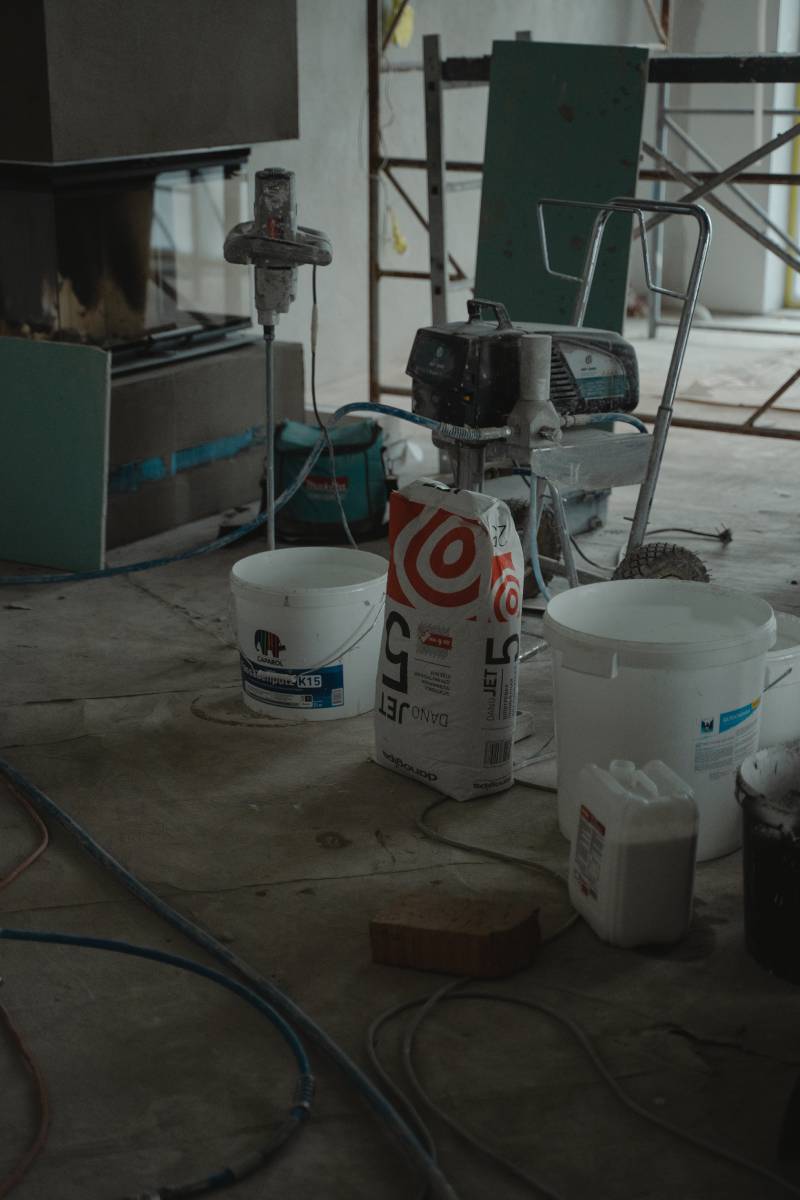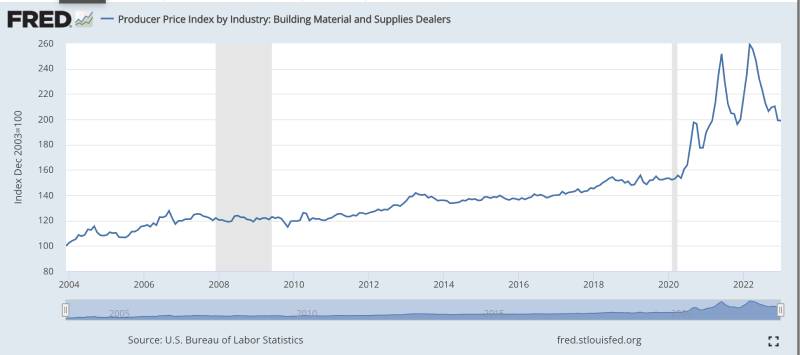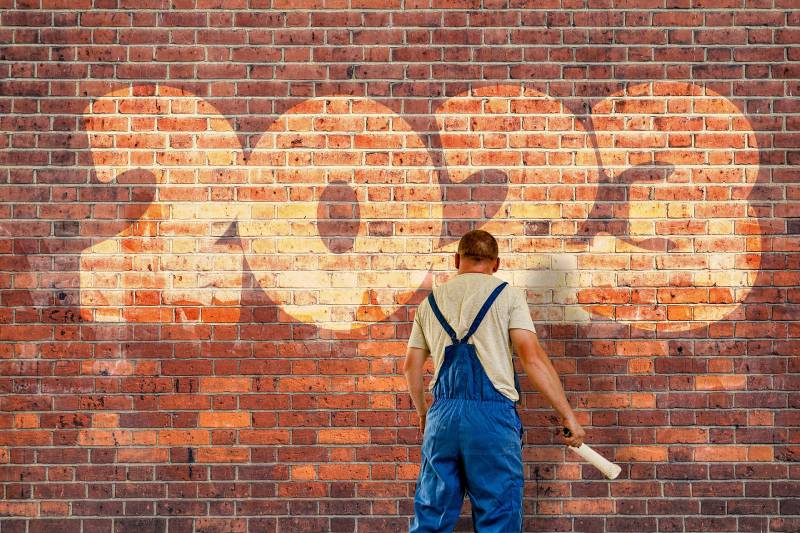
Everything You Need to Know About 2023 Building Materials Prices
Construction contractors have a lot to deal with—and right now, one of the biggest concerns is the rise in material prices.

You’ve probably noticed the price of things like chicken, eggs, and milk on the rise over the past few years. It can be frustrating seeing stuff you used to be able to afford become increasingly expensive, but it’s not just groceries that have become more costly. Construction materials have also risen in price recently.
In fact, along with a shortage of workers, rising building material prices are one of the biggest problems construction contractors need to grapple with these days, leaving many wondering, “Will construction prices go down?”

Chart from https://fred.stlouisfed.org/series/PCU44414441
A Brief Overview of the Construction Material Market
Prices have been volatile in the construction material market, often spiking to unprecedented highs. Let’s look at the cost of lumber as an example.
When the pandemic arrived, it drastically altered lumber supply and demand. More and more people renovated their homes, or constructed brand-new ones, causing lumber prices to reach $1,500 per 1,000 board feet in April 2021.
However, with higher interest rates and a cooling housing market, lumber’s price has been dropping. Still, with North America lumber inventory at all-time lows, lumber prices will likely rise again in the near future.
It’s truly a roller coaster—and lumber is far from the only material experiencing significant price changes. Everything from steel to stone to millwork will cost you more now.

4 Factors May Impact Construction Materials Prices in 2023
So, why exactly are construction materials priced so high at the moment? There are a few reasons:
The War in Ukraine
The effects of the war in Ukraine go beyond Europe. Over the past year, it has impacted energy prices, food prices, and the global supply of commodities. As for the construction industries, the prices of fuel, copper, aluminum, diesel, cement, and asphalt have been particularly affected by the war in Ukraine and the resulting supply-chain issues.
Ongoing Supply Chain Disruptions
While the war in Ukraine worsened the supply-chain problems, they had already been a major issue. Between the COVID-19 lockdowns in China, the shortage of shipping containers, and the congestion at American ports, contractors were often unable to get their hands on materials—or they were left paying through the nose to secure them in a timely manner.
While some wrinkles in the supply chain have already been ironed out, things won’t automatically go back to normal in 2023. Between existing geopolitical conflicts, climate change, and a shortage of port workers and truck drivers, supply-chain disruptions will likely persist for the foreseeable future.
Demand for Construction
With today’s high inflation rates and low housing inventory, housing affordability is at its worst in years. As mortgage rates stabilize, the market may go through a rough patch, and the cost of building materials may fluctuate. However, demand for housing will likely quickly rebound towards the tail end of 2023 or the beginning of 2024.
A Recession
The U.S. economy may be headed toward a recession in 2023, which could also impact material prices. If the Federal Reserve continues to hike interest rates, consumer spending will decline, and a recession may occur, leading to volatility in building material prices.

The 2023 Forecast for Construction Materials Prices
So, if demand for construction remains relatively high due to the overall housing shortage of single-family and multi-family housing, a recession arrives, the war in Ukraine continues, and supply chain disruptions are part of the new normal, where does that leave the price of construction materials for 2023? Will construction prices go down?
It’s impossible to tell the construction cost forecast for 2023 for sure, but we can expect some price fluctuation as the market changes. The entire construction industry will likely contract for at least a few months, but pricings are unlikely to return to pre-pandemic rates due to inflation and supply chain problems. Plus, while the housing market may be more affected by a recession, infrastructure spending by the government will likely continue.
Given that the price of materials has been steadily rising for years and the demand for housing and building is, overall, on the rise, any decrease will likely be temporary. When it comes to the construction cost forecast for 2023, economists predict that the cost of building materials will rise by an average of 4%.

5 Strategies to Get Your Materials at Low Prices
Though construction material prices have been in a general uptrend for years, that doesn’t mean you have to consistently shell out loads of money. Saving on construction materials doesn’t have to be complicated. You can:
Visit Local Building Materials Suppliers
The shop local trend has been going strong for years—and it’s worth considering if you’re after discounts on materials. After all, some local building materials suppliers or small businesses will be willing to offer you contractor discounts if you meet their monthly minimum requirement. Keep in mind that the more materials you purchase, the more likely you are to receive a discount.
Plus, since they’re local, they may already have the materials on hand, meaning you won’t have to deal with the ongoing supply chain disruptions or exorbitant shipping prices! It’s a win-win.
Take a Trip to Home Improvement Stores
Home improvement stores like Lowes and Home Depot aren’t just for DIY projects. These big-name suppliers often offer contractor packages and bulk discounts. In some cases, you can even send your materials list to the store online and they’ll apply a bulk discount for you. You can cut anywhere from 15% to 50% off the price of your building supplies by buying from home improvement stores in bulk.
Use Several Suppliers
It’s never a good idea to have a single supplier. After all, what happens if they go under or their supply chain has a serious problem? However, in addition to providing peace of mind, using several suppliers can help you cut costs.
When you work with multiple suppliers, they know they need to compete for your business. They can’t charge whatever they want and get away with it because you have other options. To keep your business, they may even offer you discounts!
Plus, you can receive and compare quotes from your suppliers. This way, you’ll always get the best deal.
Build Strong Relationships with Your Suppliers
Forging a deep relationship with your suppliers should be a top priority. If you and your suppliers get along, they’ll be more likely to offer you a discount. Even a 1% or 2% discount can make a big difference over time, so do your best to cultivate strong relationships with your suppliers.
Above all, make sure to pay on time or, if possible, pay early. Suppliers love timely customers and will do everything they can to keep them happy. Don’t ask for a discount on every order, as that could negatively impact your relationship with a supplier, and always include an accurate material list. After all, if a supplier has to make multiple trips to your site or pick up additional materials every time you order, they’ll end up wasting time and money, which could damage your relationship and ability to get discounts.
Use Online Resources To Compare Prices
You can also use online resources to compare building materials prices. This will allow you to avoid spending more than you need and quickly see what deals are out there.
However, not all online resources are created equal. Some are difficult to navigate, while others simply don’t have enough suppliers to compare. If you’re after a reliable online resource with hundreds of vendors, look no further than AMAST.
All About AMAST, the Online Solution for Wholesale Building Materials
AMAST’s online B2B marketplace is one of the best places to compare prices and find cost-effective yet high-quality materials. With over 400 verified vendors and more than 300,000 SKUs, AMAST has plenty of products and prices to compare from local and nationwide suppliers. Whether you’re in need of a sheet of PVC, a faucet, or millwork, AMAST has you covered.
What’s more, getting quotes from AMAST’s vendors is a fast, hassle-free experience that requires no money and no commitment. You can simply give us your shopping list and we’ll return to you with quotes from our trusted vendors. Contractors who use AMAST can quickly compare product prices and reduce their construction costs by up to 15%, so keeping construction costs under control is a breeze.
Cut Costs With AMAST—No Matter What Happens in 2023
Construction prices have been on the rise in recent years, and they’ll likely remain high in 2023. However, you aren’t stuck paying through the nose for building materials. In addition to using multiple suppliers, building strong supplier relationships, and checking out local and home improvement stores, you can use AMAST.
Not only can our online B2B marketplace save you time, but it can also help save you money, especially during times of economic uncertainty. With AMAST, you’ll be able to access high-quality materials and products at fair prices from reputable vendors.
Ready to start saving on construction materials and buying quality wholesale building materials? Check out what AMAST has to offer today!